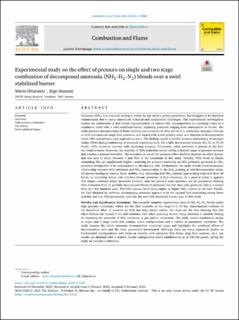| dc.description.abstract | Ammonia (NH3) is a practical hydrogen vector for gas turbine power generation, but struggles to be deployed commercially due to many unresolved technical and fundamental challenges. This experimental investigation focuses on combustion of fuel blends representatives of various NH3 decomposition (or cracking) ratios in a combustor fitted with a swirl-stabilized burner, exploring pressures ranging from atmospheric to 10 bar. The study presents measurements of flame stability and emissions of NOx and N2O in combustor strategies relevant to both conventional single lean operation and staged with a rich primary zone, as a function of decomposition ratios (DR) and primary zone equivalence ratio. The findings reveal a notable pressure-dependency of nitrogen oxides (NOx) during combustion of ammonia containing fuels. For a fully decomposed mixture (H2 single bondN2 at 75/25 %vol.), NOx emissions increase with increasing pressure. Conversely, when ammonia is present in the fuel, the trend reverses. However, the majority of NOx reduction occurs within a limited range of pressure increase and reaches a plateau thereafter. The transition at which the pressure effect declines depends on other factors, and was seen to occur between 5 and 9bar in the conditions of this study. Notably, NOx levels in flames containing NH3 are significantly higher, rendering the pressure sensitivity on NOx primarily governed by NH3 presence, irrespective of its concentration in the fuel (i.e. DR). Furthermore, the study reveals a non-monotonic relationship between NOx emissions and NH3 concentration in the fuel, peaking at mid-decomposition ratios. All factors tending to weaken flame stability (e.g. increasing fuel NH3 content, approaching lean/rich blow off limits, or increasing burner exit velocity) favour emissions of N2O emissions. As a general trend, it appears that longer residence times, increased pressure, and rich primary zone operation are all parameters limiting NOx formation from all partially decomposed blends of ammonia, but that they only positively add to a certain limit of a few hundred ppm. This NOx plateau level being higher at higher NH3 content in the fuel. Finally, the fuel obtained by perfectly decomposing ammonia appears to be the optimal fuel associating strong flame stability and low NOx propensity, even for the non fully premixed burner type of this study. | en_US |

